The Williams family of painters, also known as the Barnes School, is a family of prominent 19th-century Victorian landscape artists known for their paintings of the British countryside, coasts and mountains. They are represented by the artist Edward Williams (1781–1855), his six sons, and several grandchildren.

River Landscape with Windsor Castle

Llyn-y-Ddinas, North Wales, 1873
Barnes School
Origins and style
Edward Williams (1781–1855), the patriarch of the Williams family of painters and founder of the Barnes School of artists, was a successful landscape artist, who became very popular during the Victorian era for painting moonlit scenes of the English countryside. He was followed as a landscape artist by his six sons and several of his many grandchildren.[1] Over the years, this artist family became known as the Barnes School, so called because from 1846 until about the turn of the century, Williams, several of his sons, and some of his grandchildren worked out of neighboring studios in the then rural setting of Barnes, London, on the south side of the Thames River.[2]
The Williams family was probably first referred to as a school by the Athenaeum magazine, whose July 14, 1855 obituary for Edward Williams wrote that, "[he] trained what must almost be called a school of landscape painters in his sons . . . whose works . . . do credit to him who trained them." This same journal in 1886, and subsequently the Dictionary of National Biography, wrote that Williams' son Sidney Richard Percy was "founder of the so-called School of Barnes".[3] Nonetheless, the role of Edward Williams as patriarch and mentor of Percy and his brothers is undeniable.[4] Percy specialized in painting landscape scenes with cattle, and if the description "Barnes School" implies just this style of landscape, then certainly it is Percy who developed that theme to a greater degree than any in his family.[5] However, if the Barnes School implies a style employed by the family as a whole wherein the natural setting of the landscape, not the figures in it, sets the mood for the painting, then Percy's father Edward Williams must be considered the founder of the Barnes School.
Paintings of the Williams family are characterized by farm and village settings, cloudy mountain vistas, boats plying marshes along the Thames, and cattle grazing in meadow wetlands, usually painted in soft earth tones and subtle greens, and often displaying a complex interplay of light and shadow. Edward Williams was a master at creating scenes with complex lighting in which the figures, often people and boats, were subordinate to the scenery, in an age when landscape painters were considered subordinate to figure painters. His sons developed this style further, each adding their own variations. Their paintings were extremely popular in Victorian England and remain so today. Examples of the work of Edward Williams and all six of his sons, as well as several of his grandchildren hang today in prominent museums, and some Williams family paintings, especially those of Henry John Boddington and Sidney Richard Percy, command impressive prices at auction.[6]
Family members
The best-known members of the Williams Family (Barnes School) are the six sons of Edward Williams, who is sometimes called Old Williams to avoid confusion with his oldest son. Unlike many popular Victorian artists, the Williams generally enjoyed a fair degree of success during their lifetimes. They exhibited prolifically with the Royal Academy, the British Institution, the Suffolk Street Gallery of the Society of British Artists, and many other Victorian art venues of the time.[7] Old Williams' sons follow.
- Edward Charles Williams (1807–1881)
- Henry John Boddington (1811–1865)
- George Augustus Williams (1814–1901)
- Arthur Gilbert (1819–1895)
- Sidney Richard Percy (1821–1886)
- Alfred Walter Williams (1824–1905)
Edward Williams, Sr. also had a daughter Emily Ann Williams (1816–1857). Though she did not become a painter like her brothers, she was the mother of the landscape artist Charles Leslie, who is considered a member of the Williams family.[8]
Sidney Richard Percy is the best known of Edward Williams' sons, and arguably was the most successful. His paintings are also the most sought after today. However, Henry John Boddington was well known in his lifetime as well, and he was even elected a member (RBA) of the prestigious Royal Society of British Artists, a recognition not achieved by any of his brothers.
Several of Old Williams' grandchildren became landscape painters and exhibited paintings with the Royal Academy, which was considered the most prestigious of the London exhibitions. They exhibited with the other major art venues as well, particularly at the Suffolk Street Gallery of the Society of British Artists.[9] Shown below are those grandchildren whose names appear in the exhibition catalogs,[7] and who, with the exception of Amy Dora Percy, are listed in Wood's (1995) Dictionary of Victorian Painters.
- Edwin Henry Boddington (1836–?) – son of Henry John Boddington
- Walter Williams (1834–1906) – son of George Augustus Williams
- Caroline Fanny Williams (1836–1921) – daughter of George Augustus Williams
- Charles Leslie (1839–1886) – son of Emily Williams (a daughter of Old Williams)[8]
- Kate Gilbert (1843–1916) – daughter of Arthur Gilbert
- Horace Walter Gilbert (1855–1928) – son of Arthur Gilbert
- Amy Dora Percy (1860–1957) – daughter of Sidney Richard Percy
- Herbert Sidney Percy (1863–1932) – son of Sidney Richard Percy

Charles Leslie, Caroline Fanny Williams, and Herbert Sidney Percy are probably the best known of the grandchildren of Edward Williams, and their paintings show up regularly at auctions and in galleries. Edwin Henry Boddington had the most works exhibited at the Royal Academy, which indicates his talent, but his success and subsequent recognition was limited, some say by a lack of industry and perhaps a tendency to rest on the accomplishments of his father.[10] All four of these grandchildren have works displayed in one or more British museums.[11]
Though he is seldom identified with the Barnes School, the figure painter William Shayer (1787–1879) nonetheless collaborated on occasion with several of the Williams brothers, especially with Edward Charles Williams and sometimes with Edwin Henry Boddington and Sidney Richard Percy.[12] Said to somehow be related to the family by marriage, Shayer would add figures, usually people or farm animals, to Williams landscapes otherwise barren of this ornamentation.[13] Near Wantage, Berkshire is an oil on canvas that is one well-known example of such a collaboration between Shayer and Edward Charles Williams.[14] The Old Roadside Inn shown here is another example of a Shayer and Williams collaboration. Shayer, a contemporary of Edward Williams senior, had four sons who followed him as a painter and are known collectively as the Shayer family of painters, a parallel to the Williams family.[15]
Beginning with Edward Williams the engraver and his brothers-in-law James Ward, William Ward, George Morland and Henry Chalon, the Ward and Williams families represent five generations of engravers and painters (see the family tree below), as both Amy Dora Reynolds (née Percy) and Herbert Sidney Percy had children who followed careers in art. Although both of Walter William's children became painters also, little is known about them. However, none of these fifth-generation descendants were landscape painters in the tradition of the Barnes School. Richard Frederic Reynolds (1888–1918), the oldest son of Amy Dora Reynolds (née Percy) was a pupil of the genre painter Stanhope Forbes, R.A., but his career was cut short when he was killed in France during the First World War.[16] His cousin, Sidney Dolores Percy (1892–1965), the only daughter of Herbert Sidney Percy, received a scholarship to the Royal Academy of Art and studied at St. John's Wood School of Art in London before moving to the United States, where she was a portrait painter in California under her married name of Sidney D. Bunce.[17]
Family tree
Family tree for the Willams family of painters showing artists descended from Edward Williams the engraver.[18]
| Edward Williams the engraver c.1755–1797? | Mary Ward | William Ward 1762–1826 | Ann Ward married George Morland 1763–1804 | James Ward 1769–1859 | Sarah Ward married Henry Bernard Chalon 1770–1849 | ||||||||||||||||||||||||||||||||||||||||||||||||
| Edward Williams "Old Williams" 1781–1855 | Ann Hildebrandt | ||||||||||||||||||||||||||||||||||||||||||||||||||||
| Edward Charles Williams 1807–1881 | Henry John Boddington 1811–1865 | George Augustus Williams 1814–1901 | Arthur Gilbert 1819–1895 | Emily Ann Williams 1816–1857 | Sidney Richard Percy 1821–1886 | Alfred Walter Williams 1824–1905 | |||||||||||||||||||||||||||||||||||||||||||||||
| Edwin Henry Boddington b. 1836 | Charles Leslie 1839–1886 | ||||||||||||||||||||||||||||||||||||||||||||||||||||
| Walter Williams 1834–1906 | Caroline Fanny Williams 1836–1921 | Kate Gilbert 1843–1916 | Horace Walter Gilbert 1855–1928 | Amy Dora Percy (Mrs. Fred Reynolds) 1860–1957 | Herbert Sidney Percy 1863–1932 | ||||||||||||||||||||||||||||||||||||||||||||||||
| Florence Ada Williams 1859–1927 | Cyril Stanley Williams b. 1863 | Richard Frederic Reynolds 1888–1918 | Sidney Dolores Bunce (née Percy) 1892–1965 | ||||||||||||||||||||||||||||||||||||||||||||||||||
Art
Influence of art
The Victorian era (1837–1901) was a time when many Britons raised in the country became wealthy during the industrial revolution and were forced to leave their rural roots and relocate to the City of London. Nostalgic for the beauty and solitude of woodlands and meadows they once knew, with wealth enough to indulge in luxuries such as the arts, many spent large sums of money on country landscapes that reminded them of their childhoods. Painters able to capture on canvas the beauty of rural settings became immensely popular. Although royal recognition and membership in prestigious societies generally went to those artists who painted grand battle scenes and portraits, the public bought landscapes.[19]
The popularity of Victorian landscapes declined in the 1880s with the emergence of Impressionism as an art style, and mirrored a decline in the fortunes of the Williams brothers. "Williams [family] paintings were designed ... to be displayed in homes, rather than museums or galleries, and these gentle landscapes fell into obscurity as tastes changed."[20] Ultimately the only member of the Barnes School to receive formal recognition was Henry Boddington with his 1842 election to the Society of British Artists (RBA). It would appear that none of the Williams family were ever considered for membership in the Royal Academy (RA), the most prestigious recognition of them all. In fact, of the most popular landscape artists of the Victorian era only Benjamin Williams Leader (1831–1923) was elected an academian to the Royal Academy. Ironically, Leader had been born Williams, but changed his surname to avoid being confused as a son of Edward Williams, to whom he was unrelated.
Despite little critical acclaim during their lifetimes, Sidney Richard Percy, Henry Boddington and Arthur Gilbert were three of the most popular landscape artists of the Victorian era, probably more so than the aforementioned Benjamin Leader.[21] Furthermore, the output from their family was immense, with over 800 paintings exhibited with the Society of British Artists alone.[22] This, plus the enduring popularity of their works today, reflected by the high prices some Williams family paintings bring in auction,[6] demonstrates the importance of the Barnes School in the history of Victorian art.
Paintings
Examples of paintings by some of the better-known members of the family.
 Edward Williams
Edward Williams
A Rustic Rural Landscape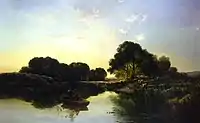 Edward Charles Williams
Edward Charles Williams
Out Fishing, 1855 Henry John Boddington
Henry John Boddington
Devonshire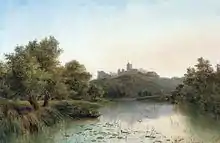 George Augustus Williams
George Augustus Williams
Windsor Castle from the Thames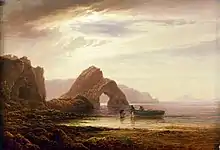 Arthur Gilbert
Arthur Gilbert
Gilter's Point, Tenby, by Moonlight, c.1873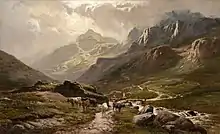 Sidney Richard Percy
Sidney Richard Percy
Grizedale, Westmorland, 1883 Alfred Walter Williams
Alfred Walter Williams
Off Hastings, sunrise, 1885 Charles Leslie
Charles Leslie
Mole Hebog, 1885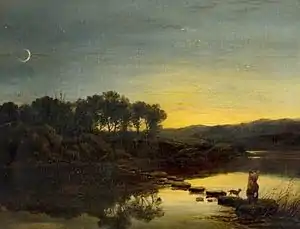 Edwin Henry Boddington
Edwin Henry Boddington
Landscape, Sunset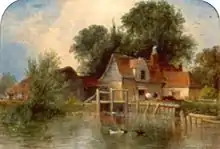 Caroline Fanny Williams
Caroline Fanny Williams
Mapledurham, Berkshire Horace Walter Gilbert
Horace Walter Gilbert
Meads near Egham, Surrey, 1884 Herbert Sidney Percy
Herbert Sidney Percy
A ship anchored at low tide
Notes
- ↑ Ottley (1866), p. 178; Wornum (1869), p. 168; Grundy (1935); and Omell (1975).
- ↑ Reynolds (1975), p. 7.
- ↑ Athenaeum (1886), i. 592; and Lee (1909), v. XV, p. 874.
- ↑ Grundy, 1935; Omell, 1975; and Reynolds, 1975
- ↑ Reynolds (1997), p. 42-45.
- 1 2 S R Percy's Landscape with cattle and figures, 1875 sold in 2000 at Phillips London for $195,656 USD, and his Lever's waters, Coniston, 1875 sold in 2008 at Sotheby's London for $147,259 USD. Some of Henry Boddington's works have approached the $100,000 USD sales mark, and at least four of Sidney Richard Percy's paintings have exceed that. www.findartinfo.com and www.artinfo.com. Retrieved 18 Oct 2012.
- 1 2 see individual artist listings in Graves (1884).
- 1 2 Michael S. Clark. "Charles Leslie". History of the Percy, Williams and Ward families. Retrieved 18 October 2012.
- ↑ see individual artist listings in Graves (1970)
- ↑ Reynolds (1975) p. 24-25.
- ↑ see individual artist listings on BBC Your Paintings. Retrieved 20 Oct 2012
- ↑ Stewart & Cutten (1981), p. 23
- ↑ Reynolds (1975) p. 18-19 & 22.
- ↑ "Near Wantage, Berkshire" (PDF). Artsolution.net. Retrieved 18 October 2012.
and an image of the painting at Wikigallery. Retrieved 18 Oct 2012. - ↑ Stewart & Cutten (1981)
- ↑ Reynolds (1997), p. 45.
- ↑ Reynolds (1997), p. 45; and "Sidney Bunce specializes in portraiture". Western Woman: v. 13, no 4, p. 49. 1938.
- ↑ based on a family tree originally shown in Grundy (1935); and expanded upon by Reynolds (1975), p. 3.
- ↑ Wood (1995), vol 2 (Historical Survey).
- ↑ Reynolds (1975), p. 10.
- ↑ see "Victorian Landscape Art". Rehs Galleries. Retrieved 20 October 2012.
- ↑ Reynolds (1975) p. 11.
References
- Grant, Maurice Harold (1974). A Chronological History of the Old English Landscape Painters (in Oil) from the XVIth Century to the XIXth Century: Describing More than 800 Painters. Leigh-on-Sea: F. Lewis. 724 p. in 8 vol. ISBN 9780853175902.
- Graves, Algernon (1884). Dictionary of artists who have exhibited works in the principal London exhibitions from 1760–1893. London: George Bell & Sons. 265 p.
- Graves, Algernon (1970). Royal Academy of Arts: a complete dictionary of contributors and their work from its foundation in 1769–1904. East Ardsley: S.R. Publishers. 8 vol.
- Grundy, C.R. (1933). A catalogue of the pictures and drawings in the individual collection of Frederick John Nettlefold.
- Lee, Sidney, ed. (1895). . Dictionary of National Biography. Vol. 44. London: Smith, Elder & Co. p. 429.
- Omell (N.R.) Gallery (1975). The Williams family of painters: featuring works by E. Williams, E.C. Williams, H.J. Boddington, G.A. Williams, A. Gilbert, S.R. Percy, A.W. Williams, W. Williams, Miss C.F. Williams, E.H. Boddington, Miss K.E. Gilbert, H.W. Gilbert : exhibition [held] April 9th to May 9th [1975]. N.R. Omell Gallery. 94 p.
- Ottley, Henry (1866). "Edward Williams". Biographical and critical dictionary of recent and living painters and engravers, forming a supplement to Bryan's dictionary of painters and engravers. London: Henry G. Bohn. p. 184.
- Pavière, Sydney Herbert (1968). Dictionary of Victorian landscape painters. Leigh-On-Sea, England: F. Lewis. 143 p. ISBN 9780853171119.
- Reynolds, Jan (1975). The Williams family of painters. Woodbridge, Suffolk: Antique Collectors Club. 331 p. ISBN 9780902028418.
- Reynolds, Jan (1997). "Landscapes with Cattle". Antique Dealers and Collectors Guide (November 1997): 41–45.
- Stewart, B. & Cutten, M. (1981). The Shayer Family of Painters. London: F. Lewis Publishers. 143 p. ISBN 9780853170921.
- Wood, Christopher (1995). Dictionary of Victorian painters (3rd ed.). Woodbridge: Antique Collectors Club. 2 vol. ISBN 9789524924139.
- Wornum, R. N. (1869). "Edward Williams". Descriptive and historical catalogue of the pictures in the National Gallery: with biographical notices of the deceased painters. British school. London: National Gallery. p. 168.